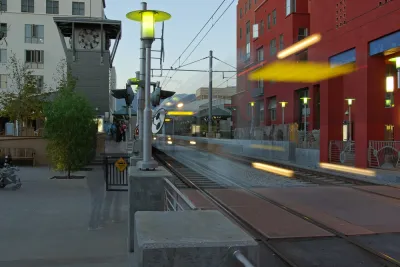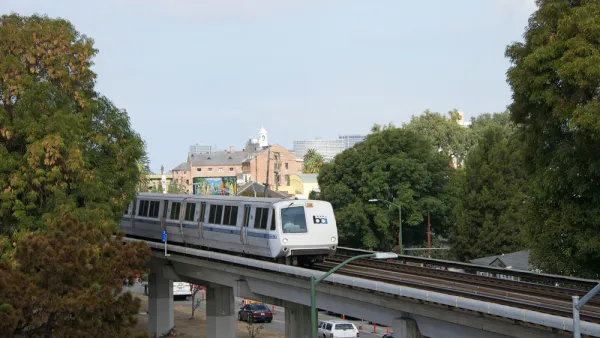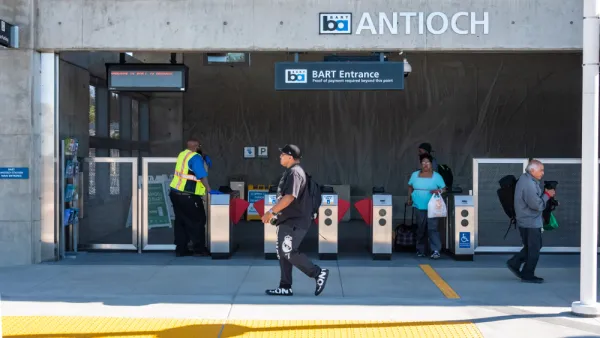Transit, affordable housing, TODs, active transportation and local governments should all come out ahead should Brown sign SB 961. The bill follows in the path of earlier legislation that created enhanced infrastructure finance districts.

Affordable housing by rail stations and high-frequency bus stops may be the biggest winner if Gov. Jerry Brown signs Senate Bill 961 by Senator Ben Allen (D – Santa Monica) as "40% of the tax increment [goes] to affordable housing and 10% to urban greening and active transportation," writes Gloria Ohland for Move LA, a Los Angeles non-profit that advocates for public transit that sponsored the bill.
The remainder of the funds can be used for transit capital projects including stations and programs supporting transit ridership.
Ross Zelen, editor of The Planning Report, wrote about the legislation last May in the wake of the demise of the far-reaching Senate Bill 827 by Scott Wiener, D-San Francisco.
In reaction to legislation threatening to usurp local control of housing and land-use policy by the state, California elected officials have been scurrying to reframe the conversation.
In an interview with The Planning Report, Sen. Allen and MoveLA Director Denny Zane laid out the goal of allowing cities to capture tax increment monies and apply such funds towards affordable housing and transportation infrastructure.
The bill's title is "enhanced infrastructure financing districts." In an August 2016 Planetizen blog post, "A New Financing Tool for California: Enhanced Infrastructure Finance Districts," Linda L. Day, Emeritus Professor of City and Regional Planning, Cal Poly, San Luis Obispo, Calif., describes the 2014 and 2015 legislation that re-established tax increment financing after Gov. Jerry Brown signed legislation eliminating redevelopment agencies in 2012. More information available at California EIFD's.
Unlike their redevelopment agency predecessors, enhanced infrastructure financing districts, or EFIDs, "only get contributions from agencies that agree to join up and create an infrastructure-financing plan," wrote Planetizen associate editor Elana Eden in a May 2016 post, "Economic Development 2.0': California’s Enhanced Infrastructure Financing Districts."
In other words: They have to cooperate.
According to the Aug. 30 legislative analysis, SB 961 "allows certain EIFDs to issue debt for affordable housing near transit without voter approval." However, the city or county must follow detailed procedures to solicit and respond to public comments in the process.
In his aforementioned post, Zelen describes how the legislation builds on what is known as the Neighborhood Infill Finance and Transit Improvements Act of 2017, based on Assembly Bill 1568 by Allen's Santa Monica colleague, Assemblymember Richard Bloom.
Cooperation or preemption?
As Eden and Zelen observed above, EFIDs are based on cooperation among agencies in the absence of any state or regional preemption of local land use authority.
Another planning bill on the governor's desk, AB 2923 by Assemblymembers David Chiu (D-San Francisco) and Timothy Grayson (D-Concord), co-sponsored by the Non-Profit Housing Association of Northern California and the State Building and Construction Trades Council, does involve preemption around Bay Area Rapid Transit (BART) stations for the purpose of creating transit-oriented developments with a minimum of 30 percent affordable housing units.
It may prove insightful to follow the implementation of these two bills, one heavy-handed and the other contingent upon cooperation and a willingness to invest in transit areas, should both become law. Gov. Brown has until Sept. 30 to decide whether to sign them.
Hat tip to Darrell Clarke.
FULL STORY: SB 961 Is On Its Way to the Governor's Desk!

Analysis: Cybertruck Fatality Rate Far Exceeds That of Ford Pinto
The Tesla Cybertruck was recalled seven times last year.

National Parks Layoffs Will Cause Communities to Lose Billions
Thousands of essential park workers were laid off this week, just before the busy spring break season.

Retro-silient?: America’s First “Eco-burb,” The Woodlands Turns 50
A master-planned community north of Houston offers lessons on green infrastructure and resilient design, but falls short of its founder’s lofty affordability and walkability goals.

Test News Post 1
This is a summary

Analysis: Cybertruck Fatality Rate Far Exceeds That of Ford Pinto
The Tesla Cybertruck was recalled seven times last year.

Test News Headline 46
Test for the image on the front page.
Urban Design for Planners 1: Software Tools
This six-course series explores essential urban design concepts using open source software and equips planners with the tools they need to participate fully in the urban design process.
Planning for Universal Design
Learn the tools for implementing Universal Design in planning regulations.
EMC Planning Group, Inc.
Planetizen
Planetizen
Mpact (formerly Rail~Volution)
Great Falls Development Authority, Inc.
HUDs Office of Policy Development and Research
NYU Wagner Graduate School of Public Service




























